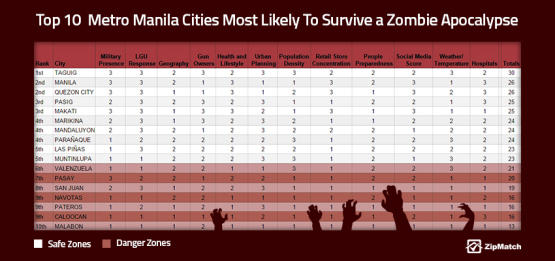A city that can be turned into a fortress against waves of zombies is safe when that time comes. This was also emphasized in Max Brooks’ famous book, “World War Z.” In the book, the US government launched an initiative called “the Redeker Plan,” wherein survivors are encouraged to hole up in a geographically defensible area to defend themselves from zombies within the country and from across borders.
In a video of a game published on IGN, the things to consider when building a livable fortress are location, resources, and an escape plan. It also helps if you have physically fit and active people who can actually contribute to the community within the fortress.
This leaves us a question: Is Metro Manila safe from a zombie apocalypse? According to an ABS-CBN article, it could, but only for a short time.
We have come up with a list of cities in Metro Manila that are considerably safe from a zombie apocalypse. The list was drawn based on the following metrics:
1. Military Presence
The number of military bases and offices per city simply indicates that there are more people who are physically and mentally prepared to fight.
2. Local Government Unit (LGU) Response
A city can be safe from a zombie apocalypse if its authorities can manage to reduce the spread of the virus. The concerns of Metro Manila being able to manage an Ebola outbreak, for one, have increased when the virus have exposed the US’ many lapses in containing it.
3. Gun Concentration
It’s been projected in the movies that the best way to kill a zombie is to shoot it in the head. In a Manila Times article, they reported that there are 600,000 unlicensed firearms in the Philippines, and maybe more because of the ease of getting firearms in the country. Most of them are more likely bought in Metro Manila through illegal gun brokers, and sometimes through soldiers and cops still on active duty, as reported in a Philstar news regarding cops selling rifles.
4. Health and Lifestyle
People who know how to run, swim, skate or bike have better chances of escaping zombies at the first few moments of pandemonium or if the fort you are holed in breaks down. We have based this metric on the number of activity centers like gyms, swimming pools, running ovals, and the number of outdoor activities held like marathons per city.
5. Urban Planning
Cities that are basically located on plateaus or have multiple access points have greater chances of getting invaded by zombies. This is because setting up adequate checkpoints will require a lot of manpower and firearms to do so. Compound buildings are also lauded as the best places to either quarantine those who were infected or house survivors because they can even withstand major earthquakes.
6. Population Density
Cities with the greatest number of people in a square kilometer will definitely record the fastest infection rates when a zombie apocalypse happens.
7. Retail Store Concentration
When you need to survive, you must have access to food and water. A city’s chance of survival against a zombie apocalypse also lies on the abundance of basic necessities. We used the number of malls and retail stores in a city as the basis for this metric.
8. People Preparedness
The impact of natural disasters in the country, particularly in Metro Manila, has heightened people’s awareness in preparing for anything that they no longer rely on the national government for help. Community-based disaster risk reduction (DRR) programs are the order of the day, particularly in locations that were most affected with weather disturbances like Ondoy.
9. Social Media Score and Local Weather/Temperature
Jet Magedon for ABS-CBN lists these as the reasons why a zombie apocalypse might not last in the country. He reasoned that the Filipino’s bayanihan spirit online showed during extreme weather had helped local and national authorities to provide relief. Moreover, the Philippine weather system discourages zombies to loiter around for very long, as they might be either be blown away by the strong winds or get carried out to the Manila Bay by flood.
10. Hospitals
The availability of top-notch hospitals in an area allows the Department of Health to be able to carry out its international health surveillance and quarantine measures by law.
By rating the city’s metrics (3 – excellent; 2 – average; 1 – fair to poor) according to our research, these are the cities that are most likely safe from a zombie apocalypse, in order:

1. Taguig
Taguig comes on top mainly because the city satisfies almost all of the requirements to build an immediate fortress should a zombie apocalypse would come in. There are only a few main access points that can be easily monitored by checkpoints. Taguig is also where Fort Bonifacio is, and it houses the major bases of the Philippine Army and Philippine Navy.
2. Manila and Quezon City
The cities are touted to be the second safest cities in the metro because of the fact that they house two important houses of power in the country: Malacañan Palace in Manila and the House of Representatives in Quezon City. However, the cities’ multiple access points, population density, and urban planning might not ensure all of the locals’ security who live along the borderlines of each city.
3. Pasig and Makati
Zombies do not do well in water. As such, Pasig and Makati locals have the best chances of surviving because they are situated beside Pasig River. Moreover, the number of buildings and skyscrapers increased the cities’ chances to survive, as they can be used as effective quarantine units or mass housing for the survivors.
Makati is home to the Gramercy Residences, which is among the tallest buildings in Metro Manila. Gramercy can be the perfect military outpost as it provides a perfect aerial view of Makati to watch over borders.
Pasig, on the other hand, has a lot of tall commercial buildings that can be used as watchtowers, like the Union Bank Plaza and One Corporate Center.
4. Marikina, Mandaluyong and Parañaque
The cities’ strongest points are its LGU responsiveness in containing health outbreaks. The Department of Health announced early this year that these cities are among the few who have managed to escape the measles outbreak.
5. Las Piñas and Muntinlupa
The cities’ lack of military presence and retail store concentration is made up by the cities’ location. Las Piñas and Muntinlupa are situated between two bodies of water: Manila Bay and Laguna de Bay.
Why do you think is your city safe from a zombie apocalypse? We’d love to get this debate going! Please share your thoughts by leaving a comment below.
Like What you've read?
-
Kyle Wiltshire
-
RyanF1
-
Keith
-











